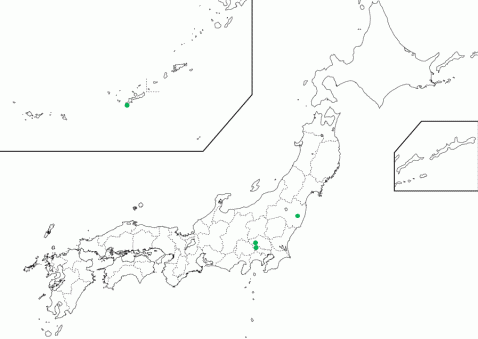Stalactite
Chemical Process (Liquid-phase growth) - Ground surface
Required Geological Setting
Neogene and Quaternary sediments, Paleogene and older sediments, Accretionary complexes
Occurrence
Stalactitic aggregate of aragonite and calcite formed on the surface of limestone caves. Stalactite in limestone caves is a kind of Tufa, soil CO2 origin calcareous sinter deposited from meteoric water, and it forms characteristic aggregates such as icicle-shaped and columnar stalactite on ceilings and floors. It also forms towers, domes, mounds, rimpools, and rimstones on floors as Tufa does. Stalactite has growth ring structure in it, and those annual rings in stalactites are used to reveal palaeoclimate. The deposition speed is estimated as a few tens micrometer/year in the mid-latitude region such as Japan, and approximately 100 micrometer/year in the subtropical region such as Okinawa islands. The dissolution process of limestone into meteoric water is considered as follows:
Carbon dioxide is dissolved in the meteoric water passing through soil. Carbon dioxide in soil is mainly originated from exhalation of plant roots and decomposition of organic matter by microbes.
Contacting limestone, CaCO3 is dissolved in the carbon dioxide-rich meteoritc water.
CaCO3 + H2O + CO2 (Soil) = Ca2+ + 2HCO3-
This reaction is most active on the limestone surface contacting soil. The longer contacting time, the more the reaction progresses until the meteoric water is saturated with CaCO3.
The deposition process of stalactite from the meteoric water rich in carbon dioxide and Ca ion is considered as follows:
Contacting air of lower CO2 partial pressure in caves, CO2 degasses from the meteoric water. Degasssing reaction is enhanced by the collision of water drips on the ground.
The following reaction progresses as a result of lowered dissolved carbon dioxide concentration in the meteoric water.
HCO3- + H+ = H2CO3 = CO2 (aq) + H2O
The pH of the meteoric water elevated and it becomes alkaline, then carbonate ions formed by this reaction.
HCO3- + OH- = CO32- + H2O
Combining carbonate ions with Ca ions in the meteoric water, calcite or aragonite deposits.
CO32- + Ca2+ = CaCO3 (Calcite)
Carbon dioxide partial pressure in limestone caves indicates seasonal changes, and annual rings are formed in stalactites based on above reactions.

Distribution of stalactite described in this site.
Mineral Assemblages
Calcite, Aragonite
Localities
- Abukuma Cave
- Gyokusen Cave
- Otake Cave
Related Occurrences
- Stalactite
- Tufa (Calcareous sinter)
- Travertine (Calcareous sinter)